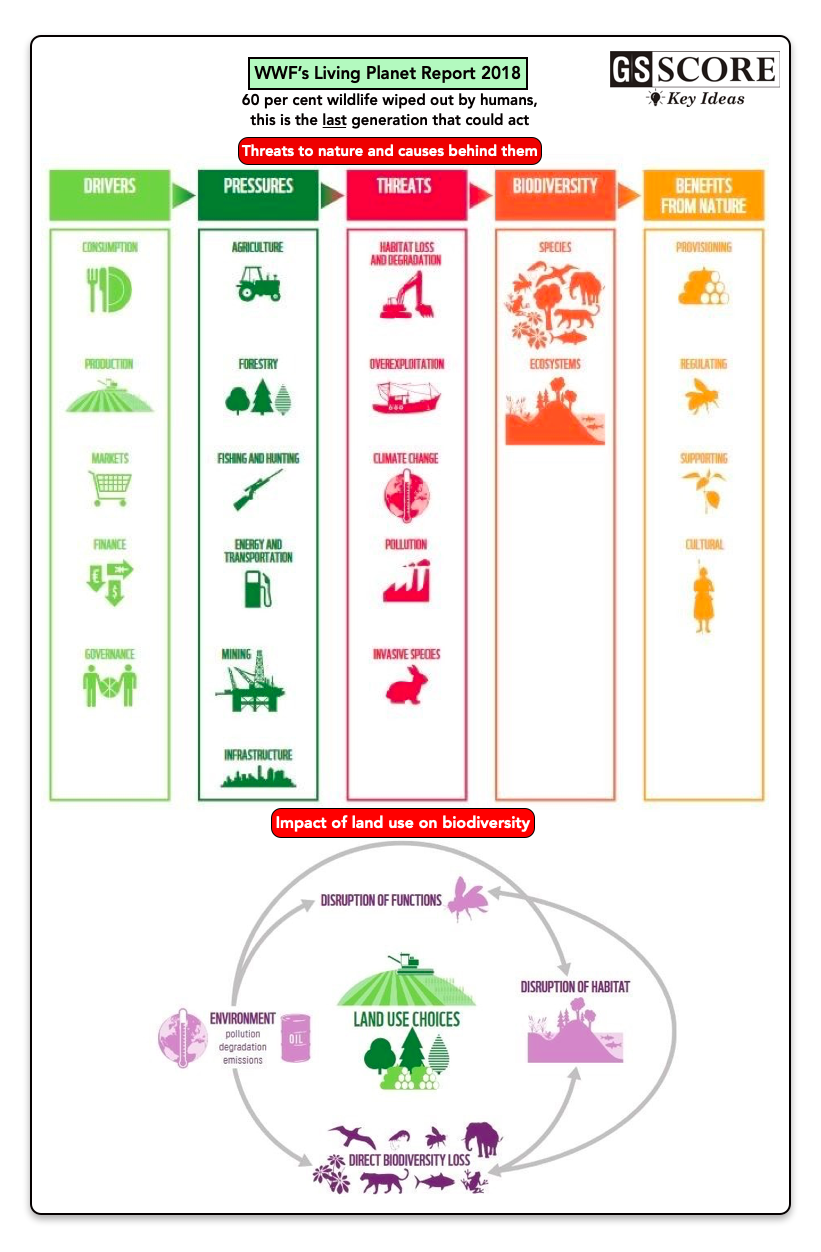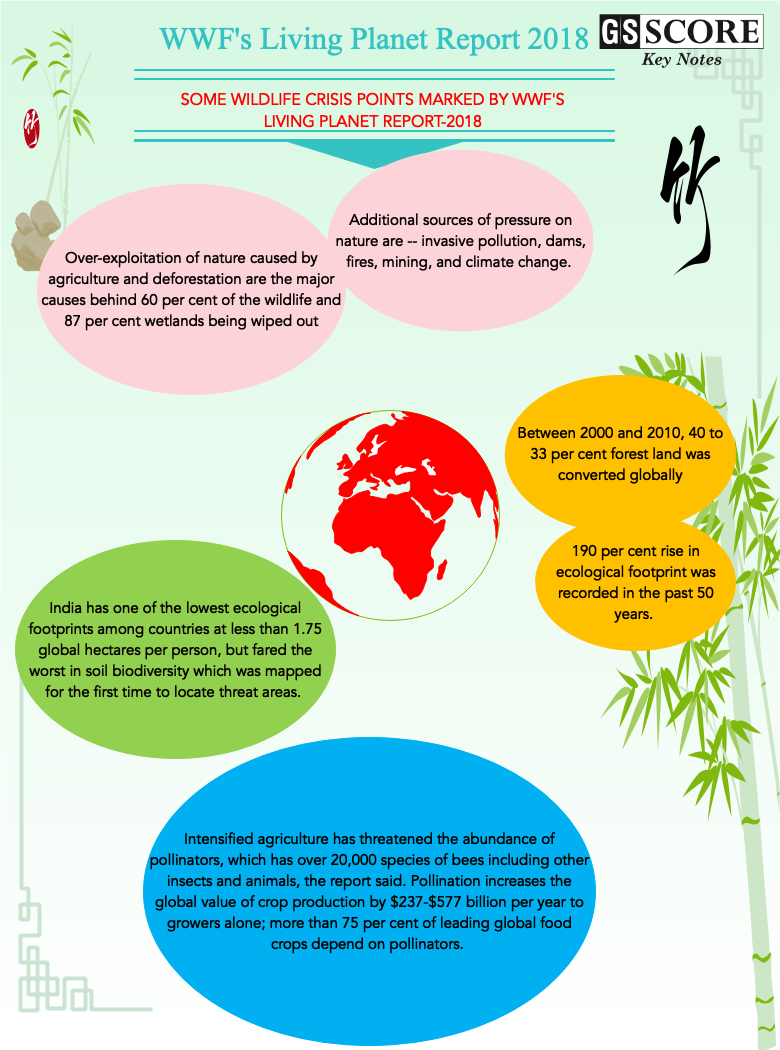

- World Wide Fund for Nature (WWF) has brought out biennial ‘Living Planet Report 2018
- A key aspect of this year’s report is the threat to soil biodiversity and pollinators.
Context
- World Wide Fund for Nature (WWF) has brought out biennial ‘Living Planet Report 2018
- A key aspect of this year’s report is the threat to soil biodiversity and pollinators.
About
What does the Living Planet Report 2018 has to say?
- The Living Planet Report, WWF’s flagship publication released every two years, is a comprehensive study of trends in global biodiversity and the health of the planet.
- The Living Planet Report 2018 is the twelfth edition of the report and provides the scientific evidence that unsustainable human activity is pushing the planet’s natural systems that support life on Earth to the edge.
- Through multiple indicators including the Living Planet Index (LPI), provided by the Zoological Society of London (ZSL), the report highlights the urgent need for a new global deal for nature and people with clear, ambitious goals, targets and metrics, to reverse the devastating trend of biodiversity loss currently impacting our planet.
Highlights of the report
WHY BIODIVERSITY MATTERS
- Our health, food and security depend on biodiversity. From medical treatments to food production, biodiversity is critical to society and people’s well-being.
- All our economic activity ultimately depends on nature. It’s estimated that, globally, nature provides services worth around US$125 trillion a year.
- Stable planetary systems have enabled modern human society to develop. Without healthy natural systems researchers are asking whether continuing human development is possible.
THREATS AND PRESSURES
- Overexploitation and agricultural activity, driven by our runaway consumption, are still the dominant causes of current species loss.
- Land degradation seriously impacts 75% of terrestrial ecosystems, reducing the welfare of more than 3 billion people, with huge economic costs.
- Bees, other pollinators and our soils – critical for global food security – are under increasing threat.
- Overfishing and plastic pollution are threatening our oceans, while pollution, habitat fragmentation and destruction have led to catastrophic declines in freshwater Biodiversity.
- New technologies and big data are helping us to understand and measure these threats and their specific impacts.
BIODIVERSITY IN A CHANGING WORLD
- The Living Planet Index has recorded an overall decline of 60% in species population sizes between 1970 and 2014.
- The Living Planet Index shows species population declines are especially pronounced in the tropics, with South and Central America suffering an 89% loss compared to 1970.
- A Freshwater Living Planet Index shows an 83% decline since 1970.
What does the report say about India?
CONCERNS
- India’s soil biodiversity is in grave peril, according to the Global Soil Biodiversity Atlas prepared by the World Wide Fund for Nature.
- As per the Risk Index Globe indicating threats from loss of above-ground diversity, pollution and nutrient over-loading, over-grazing, intensive agriculture, fire, soil erosion, desertification and climate change, India is among the countries whose soil fertility faces highest level of risk.
- India has a geographic area of 328.72 million hectare, of which land degradation is estimated to be 96.4 million hectare, or 29.32% of land area.
- While the Living Planet Index suggests that India’s ecological footprint per person is lesser than 1.75 global hectares/person, it’s high populations levels make it likely for the country to face a widening ecological deficit even if current per-capita levels of resource consumption remain the same.
- Populations of the critically endangered gharial across its range in India and Nepal declined by approximately 58% between 1997 and 2006.
- WWF-India’s report on water stewardship for industries revealed that 14 out of 20 river basins in India are already water stressed and will be moving to extreme water scarcity by 2050. The 2030 Water Resources Group has stated that by 2030, the country’s water demand is projected to be twice the available supply
Significance
The report is significant for highlighting the anthropogenic impact on biodiversity, given our health, food and security depend on biodiversity. From medical treatments to food production, biodiversity is critical to society and people’s well-being. All our economic activity ultimately depends on nature. Stable planetary systems have enabled modern human society to develop. Without healthy natural systems researchers are asking whether continuing human development is possible.
WHAT FUTURE DO WE WANT?
- Despite multiple international policy agreements and extensive research biodiversity is still in decline.
- More ambition is needed to not simply halt loss but to reverse the trend of biodiversity decline.
- The CBD 2050 vision is that “biodiversity is valued, conserved, restored and wisely used, maintaining ecosystem services, sustaining a healthy planet and delivering benefits essential for all people”.
- Conservation scientists propose a 2020-2050 ‘blueprint for biodiversity’: a vision for the future through the Convention on Biological Diversity.
- Scenarios and indicators can help imagine the future and create good policies and monitor progress.
Some quick facts from the Report
- Globally, nature provides services worth around US$125 trillion a year.
- In the 20th century, freshwater fish have had the highest extinction rate worldwide among vertebrates.
- Nearly 200 million people depend on coral reefs for protection against storm surge and waves.
- Rainforests are shrinking: almost 20% of the Amazon has disappeared in just 50 years.
- In the last 50 years, global average temperature has risen at 170 times the background rate.
- At least 70% of new small molecule drugs introduced over the past 25 years have come from a natural source.
- Almost 6 billion tonnes of fish and other seafood have been taken from the world’s oceans since 1950.
- Today, 90% of the world’s seabirds are estimated to have fragments of plastic in their stomach.
Learning Aid





